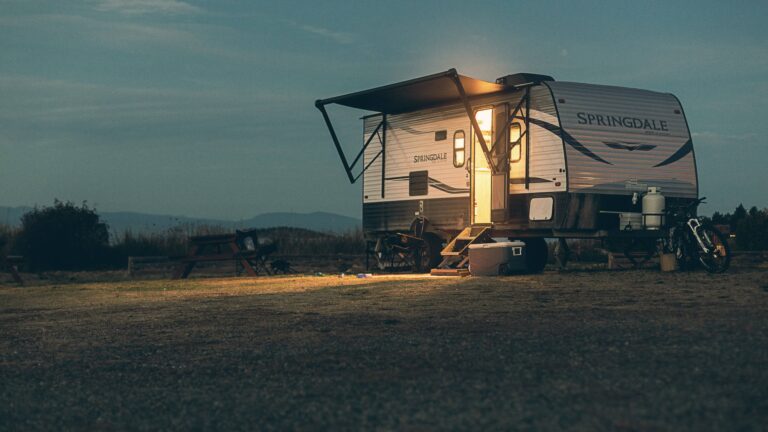
Travel trailers are awesome because they open up the world of RVing to those who may not have the means to invest in a motorhome. That said, it is important to note that in order to tow a travel trailer you need the right set up. This includes a capable towing vehicle and a good travel trailer hitch.
Not sure how to go about choosing the best travel trailer hitch? In this article, we will help you understand what to look for in a hitch, so you can be sure you’re getting the best product for your needs.
This post contains affiliate links. RVshare may receive compensation if you make a purchase after clicking on a product link.
Determining What Kind of Hitch You Need
First, you will need to know how to pick out the perfect hitch for your situation. Here are the things you should be looking for as you dive into shopping for a camper hitch.
- Type of Trailer – If you are trying to tow a bumper pull trailer, the hitch you buy will be different from the hitch you’d use for a fifth wheel.
- Hitch Weight Rating – You will want to make sure the hitch you choose can handle the weight of your trailer. Additionally, you will want to determine if a weight distribution hitch is necessary in order for your tow vehicle to handle the weight of your travel trailer.
- Drop or Rise – The hitch ball must sit at the correct height for safe towing. Make sure the height of the hitch you choose can be adjusted to the correct height.
- Ball Size – The size of your trailer coupler must match the size of the hitch ball. Make sure you know what size you need, so you get the right thing the first time.
- Durability – Obviously, durability is incredibly important when it comes to travel trailer hitches. Read reviews to make sure you are purchasing a good, solid unit.
- Ease of Use – Finally, you will want to consider the ease of use. Hitching up a trailer can be tiring. A hitch that is easy to use will make the process a lot more enjoyable.
Types of Towing Hitches
There are a variety of towing hitches available to suit different types of travel trailer and vehicle combinations. We’ve included information on each in the section below, so you can choose the best travel trailer hitch for you.
Bumper Hitch
Bumper hitches are popular for towing lighter travel trailers. This type of hitch comes with a standard 2-inch ball mount receiver as well as safety chain attachments. Additionally, look for one that features a lower hitch point to provide level trailer towing.
Weight Distribution Hitch
A weight distribution hitch is a bumper hitch, but it uses multiple points of the trailer to distribute the weight. You aren’t relying solely on a little ball. The axles carry the weight equally, and the driver will get a much better towing experience. Without weight distribution, a travel trailer will often push down on the ball mount, causing the back of the trailer to rise. This is called a squat. The truck is low at the back end, and the trailer is higher at the back end. This is not a safe way to tow.
A weight distribution hitch is a good choice if you are towing a large amount of weight, and especially if you are getting close to your RV’s towing capacity. It will cost more than a simple ball hitch, but the benefits make the extra cost worthwhile.
Sway Control Hitch
Sway control hitches are bumper hitches that help ensure your travel trailer doesn’t sway when it is towed. With sway control, the bumper pull remains straight behind your vehicle and doesn’t move to the right and left with the wind or with passing vehicles. Often, sway control is available on hitches with weight distribution. In our opinion, this is an ideal choice.
Of course, sway control is more expensive – sometimes costing an additional $100 over a hitch without sway control. If you want a multiple-point sway hitch fully installed, it can run up to $2,000 or more. These are top-of-the-line hitches that use chains, pulleys, and hydraulic pistons to safely pull your travel trailer.
Gooseneck Hitch
Gooseneck trailers are mostly used for agricultural or industrial use, particularly as the gooseneck hitch is designed to sit in the bed of a truck. It differs from a 5th wheel hitch in the fact that it uses a ball mount level with the bed (as opposed to one that sits above the surface).
5th Wheel Hitch
As we mentioned, a 5th-wheel hitch contains some similarities to a gooseneck hitch, but due to its set-up, it can allow a truck to carry more weight than most other hitches. This is because the attachment point is in the bed of the truck, instead of on the rear bumper.
Pintle Hitch
A pintle hitch comes in two variations, including a pintle hook and a pintle combination (which features both a hook and ball mount attached). This type of hitch is mostly used by vehicles that drive through rough terrain on a daily basis (i.e. industrial and farming vehicles).
Receiver Hitch Classes
Today, many travel trailers are referred to as bumper pull campers. This is because they connect right at the bumper of the truck. The receiver hitch is the most common type of hitch and is bolted to the rear of a vehicle. It allows for attaching a ball mount or other hitch-mounted accessories and falls within Class 1-5 of hitch classes.

Tow Hitch Accessories
There are often more components involved than just the receiver hitches listed above. Here are all the bits and bobs you may need to come up with in order to tow safely once you obtain a travel trailer hitch.
- Hitch Pin and Clip – This is a small metal rod that holds the ball mount in the hitch’s receiver tube. A locking one will help deter thieves.
- Safety Chains – Safety chains keep the trailer from separating completely if your trailer hitch fails.
- Reducer Sleeve – The ball mount should fit snugly into your hitch receiver. If it is too large, you may need to purchase a reducer sleeve in order to get a snug fit.
- Brake Controller – In addition to your hitch, you will also need brake controllers. The RV Wholesale Superstore has a great article on how to choose a good trailer brake controller.
Tow Vehicle Considerations
A travel trailer must be pulled by an appropriate-sized vehicle with enough power to tackle hills and keep everything under control while towing the trailer. Always check your vehicle manual for the true tow capacity of your vehicle and stick to those numbers, even leaving a small cushion is possible.
When purchasing a trailer, make sure that your vehicle can easily pull the gross weight. The gross weight rating is the most the trailer will weigh fully loaded. Therefore, it is the number to use when determining whether your vehicle can handle a trailer’s weight.
Camper Hitch Safety Tips
Now that you know the various components of an RV hitch, as well as the different products, it’s time to cover some vital RV hitch safety tips.
- Always triple-check that everything is connected properly and securely before you hit the road (especially your safety chains).
- Check your vehicle manufacturer’s recommendations for the maximum load you can tow, and never go above this weight.
- Be careful of passing vehicles such as large trucks and heavy winds, as these can increase the sway of your trailer as you’re driving. Additionally, avoid driving too fast, as high speeds can also cause heavy sway and make it more difficult to manage your vehicle.
- Allow plenty of stopping distance, as it takes longer to stop when you have a trailer attached to the back of your vehicle.
- Invest in some tow mirrors to increase your side views and minimize blind spots. These can prove especially helpful when changing lanes.
As you can see, there is a lot to know when shopping for a camper hitch. Fortunately, the information above should help steer you in the right direction, so you can safely hit the road with your travel trailer. The next step? Grabbing the gear you need to set up camp.

